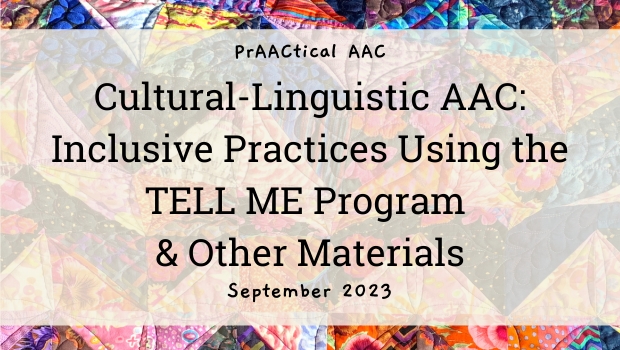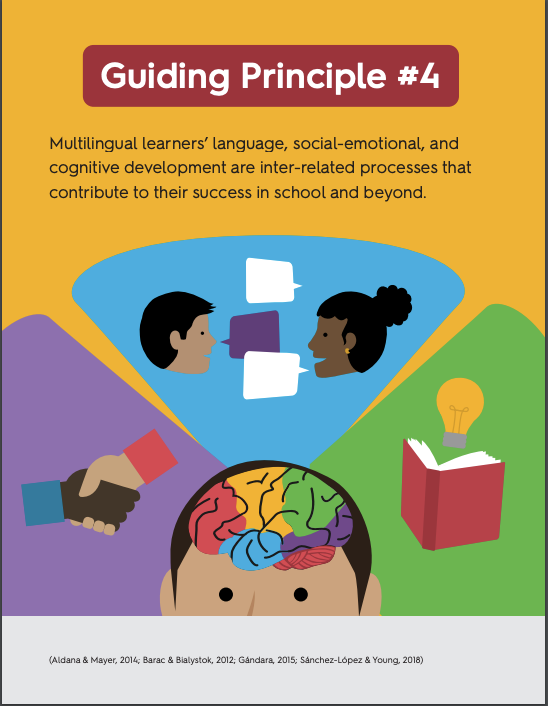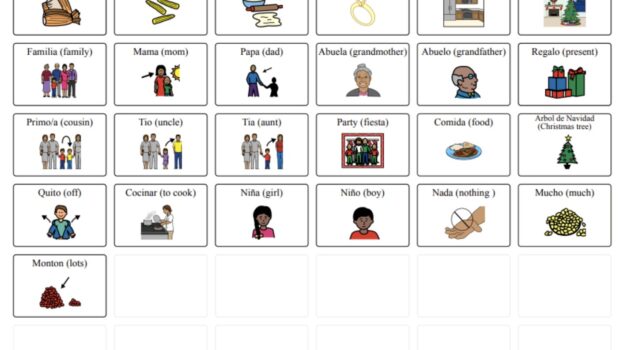Cultural-Linguistic AAC: Inclusive Practices Using the TELL ME Program & Other Materials

We are excited to continue our series on multilingual AAC support, guest-authored by BilingüeAAC. In today’s post, one member of the team, Melissa Tapia, addresses ways to use specific instructional materials with bilingual individuals. BilingüeAAC is a group of SLPs with a shared belief in providing evidence-based intervention strategies and resources to bilingual Spanish AAC clients, families, caregivers, and professionals.
Inclusive Practices Using Tell Me Program & Other Materials
How can we effectively conduct inclusive practices in our work settings?
What are some approaches or materials that we can use to integrate the culture of the home and community?
Why are inclusive practices essential for the success of our students/clients?
These are fundamental reflective questions I have found to guide me in collaborative therapy and lead to better participation with and from my clients and their caregivers.
We are Bilingue AAC, and we are here to provide helpful tools to attain best practice in AAC intervention with bilingual and multilingual communities.
For today’s post, we will be discussing inclusivity in regard to the representation of cultural values in our therapy materials. Welcome to post 5 of our 6 post series.
You can find our previous posts linked here, which wonderfully highlight best practices in bilingualism and AAC (Post 1, Post 2, Post 3, Post 4).
So let’s dive in! Research has demonstrated that creating personal connections builds enthusiasm and increases engagement in reading, writing, and verbal skills (Nathenson-Mejía & Escamilla, 2010). These personal connections are the inclusive components representing one’s culture, such as their language(s), foods, customs, and more. These components of language are also applicable when “speaking AAC”.
How do we “speak AAC” & integrate it in a meaningful and inclusive manner?
The TELL ME program is one way we can begin to incorporate AAC into the classroom at the preschool level. TELL ME stands for Teaching Early Language and Literacy through Multimodal Expression. It’s designed to help preschool classrooms integrate appropriate language and literacy learning into daily activities and routines.
TELL ME MAS is the Spanish Version available in two books. It, too, is designed to help model AAC. This program includes a list of core words based on research by Brittney Cooper and Gloria Soto and not simply translated directly from English. (These are the high-frequency words we at Bilingue AAC also implement in our templates as we have learned WE CANNOT SIMPLY TRANSLATE CORE WORDS.) The high-frequency Spanish words are portrayed in the infinitive form and can be readily conjugated into simple present tense or preterite form by a clinician, teacher, or parent. This program is very functional for all AAC users as it can be used with whichever form of AAC the team decides is best for a given child. TELL ME MAS activities use song boards, posters, and props created by teachers and therapists. You can display these in the classroom to foster an inclusive environment with print available in the home language, specifically Spanish.
This program includes WHO and WHAT posters, a STORY MAP, a SONG POSTER, SPECIAL LETTER SONG BOARDS, QUICK QUACK QUESTION CHARTS, and a PIGGY POINTER to engage young students.
This program includes translations of popular English books to Spanish. These are bilingual books written in one language and interpreted into multiple languages. Although the home language is represented, they do not necessarily contain elements that promote cultural representation in characters or the authors that write them.
BILINGUAL BOOKS
So, what are other materials we can and should use with our bilingual populations*?
WIDA Illustrated Guiding Principles of Language Development
Multilingual learners’ languages and cultures are valuable resources to be leveraged for schooling and classroom life; leveraging these assets and challenging biases help develop multilingual learners’ independence and encourage their agency in learning. (Guiding principle #1)
Multilingual learners’ language, social-emotional, and cognitive development are interrelated processes that contribute to their success in school and beyond. (Guiding Principle #4)
*Clarification: We address “bilingual populations,” however, the resources discussed are specifically for Spanish/English speaking populations. The techniques can be applied to other languages as well. The goal is inclusivity and representation that allow for translanguaging.
Taking these guiding principles into consideration. We, Bilingue AAC, have developed another helpful resource that incorporates a bilingual book available in Spanish, English, or with dual language text on a single page (bilingually). Utilizing “Too Many Tamales” by Gary Soto and illustrated by Ed Martinez, we created a Spanish/English AAC Literacy kit that includes a culturally affirming Latinx book about Maria and her family. This book encompasses many cultural values such as a holiday, traditional food, traditional names, and specific vocabulary.
The benefits of using bilingual books are that we can promote cultural awareness, deepen vocabulary in both languages, and create an inclusive space where all students feel valued.
When working with bilingual AAC users and their literacy skills, we can simultaneously work on operational competence as we encourage code-switching and model pathways on their devices to locate specific vocabulary in both languages. Students are encouraged to use their home language to engage with and process content. We want to honor and implement their full linguistic repertoire instead of approaching them as two monolingual systems.
Our Too Many Tamales AAC Literacy Kit includes the following items:
- Spanish/English template of suggested Spanish vocabulary to target based on Early Spanish Vocabulary for Children who use AAC (Soto & Cooper, 2021)
- Comprehension questions
- Sequencing sheets using First/Al principio, next/después, and last/al final
- 36 bilingual Spanish/English Core board based on Soto & Cooper (2021) and Project Core (Geist, Erickson, Hatch,2015) overlapping Spanish/English vocabulary.
- Fringe board based on Too Many Tamales by Gary Soto, illustrated by Ed Martinez.

Here, we have our fringe board that includes specific vocabulary from the text. The vocabulary is also representative of specific cultural foods, holidays, and traditions.
We also encourage that seasonal-themed books and their respective vocabularies be printed and displayed in a classroom or therapy space. Educators, therapists, and families can continue to encourage students to use both languages to comprehend text, label new items in both languages and make cultural connections.
We hope you found this information to be helpful and that you also feel empowered to begin to include culturally affirming materials into your practice today!
Join us for our final post of the series where we will highlight more about bilingual literacy and AAC!
Helpful Links:
:::::::::::::::::::::::::::::::::::::::::::::::::::::::::::::::::::::::::::::::::
About the Guest Author
 Melissa Tapia is a bicultural and bilingual Speech-Language Pathologist in Illinois. She attended Illinois State University for both undergraduate and graduate studies, majoring in Communication Sciences and Disorders and Spanish Language, Literature, and Cultures. Melissa is the owner and founder of Hablame Speech Therapy. She focuses on a client-centered collaborative model with bilingual families through in-home therapy services. She believes in helping AAC users gain access to communication in their immediate and most comfortable environment using various communication modalities and educating caregivers in how to best support their children together. Melissa manages the Instagram account, @hablame_de_language.
Melissa Tapia is a bicultural and bilingual Speech-Language Pathologist in Illinois. She attended Illinois State University for both undergraduate and graduate studies, majoring in Communication Sciences and Disorders and Spanish Language, Literature, and Cultures. Melissa is the owner and founder of Hablame Speech Therapy. She focuses on a client-centered collaborative model with bilingual families through in-home therapy services. She believes in helping AAC users gain access to communication in their immediate and most comfortable environment using various communication modalities and educating caregivers in how to best support their children together. Melissa manages the Instagram account, @hablame_de_language.
Filed under: Featured Posts
This post was written by Carole Zangari
